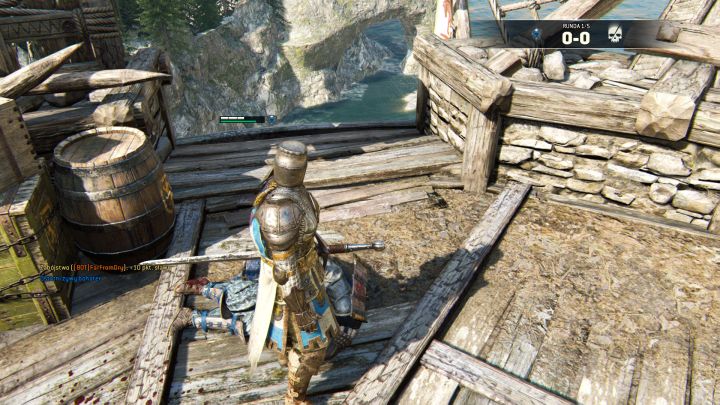For Honor: Attacks
Because For Honor is based on fights, using your attacks well is a basic thing to learn. Combining light and heavy attacks, using Guard breaks and parries and mastering all of the feats of your character will give you victory. In this chapter you will learn everything about the attacks.
Light and heavy attacks
Every character can use two types of attacks – light and heavy. The first type, as it can be easily noticed, is much faster, allows you to surprise your enemy and break through their guard but these attacks deal much less damage. Heavy attacks are much slower but they hit harder.
Light and heavy attacks can be used in all of the three stances – left, up and right. What is more, both types of attacks can be freely combined into combination attacks. Rather than an option, these combinations are a necessity because attacking only from one direction using the same type of attack is pretty much useless. It is much easier to surprise your enemy by mixing your attacks – they are much harder to block because it is more difficult to judge the moment when the attack hits. Add Guard breaks and parries (more in the next part) and you get a nice set of options during your fights.
Guard Break and throws

Another important technique related to combat is Guard Break. Sooner or later, your enemies will block and parry your attacks almost perfectly, giving you no chances in hurting them. In a situation like that you can use Guard Break, a special technique that can be used instantly but it requires you to be very close to your opponent. You must get close to an enemy, press the correct button (for more details check out the Controls chapter) and the attack, most of the time, will be successful.
Guard Break gives you a few profits. When enemy's guard is broken you can deal a few attacks (they depend on a class that you currently use), use attacks that are not related with Guard Break itself or simply throw your enemy off balance. However, there are some risks related to this move, such as:
- Guard Break doesn't interrupt enemy's attack animation. When your enemy begins swinging their weapon your Guard Break won't reach them you will simply receive damage. This situation is different in Revenge mode – your Guard Break can stop the attack animation of your enemy.
- Guard Break can be countered by an enemy. To do this, an enemy must use the same maneuver and both attacks will cancel each other. Remember about that when you notice that your enemy wants to use Guard Break.
Another thing related to Guard Break is the ability to use throws. But this doesn't mean that you can throw objects at your enemies – throws are performed on them. In order to use it you must press the Guard Break button twice – first, to reach your enemy and then the second time when you start to break their guard. By doing this you can push back your enemy (the distance depends on your equipment – more information in the chapter dedicated to the equipment), push them into a bonfire to deal them some damage or throw them off a cliff to kill them. Additionally, you can push your enemy on a wall – when they touch it they lose their balance and make it harder to move. Some of the feats also have an impact on throws – more information can be found in chapters dedicated to each hero.
Feint
Feint, or simply a faked move. This maneuver allows you to stop your attack "half-way" confusing your enemy and giving you more tactical possibilities. Feint can be done during heavy attacks – use a heavy attack in any direction and, right after the animation starts, press Feint button (more details in Controls chapter) to cancel the attack.
Thanks to this move you can easily confuse your enemy. When your enemy sees that you want to attack them using heavy attack they will try to parry it by doing the same attack. But then you can cancel your attack by using Feint and use a different attack or another heavy attack but this time from a different direction or with a different timing. If your enemy didn't expect such move there is a high chance that your attack will reach them.
Warning – Conqueror can't use Feint.
Combination attacks
Each class has additional, unique abilities. Although they are performed in the same way as other classes use their abilities, the way those attacks work are drastically different. Warden's charge can be a good example – the attack that can't be blocked, is extremely hard to dodge and it can even knock you down on the ground.
It is worth to master all of those types of moves because, when combined with other moves described in this chapter, you can increase your character's battle abilities. Remember to learn about other classes' abilities – because of that you can identify an attack that your enemy have just started and react accordingly – block it in a certain way, quickly move backwards or use a quick attack.
Tips
During attacks you should remember about things such as:
- Don't attack your enemy blindly using many attacks. Your enemy can simply wait until you are done and make a counterattack when your character is exhausted after depleting all of its stamina.
- Keep an eye on your stamina meter. If it gets below 1/3 of its length you should stop attacking and allow the meter to regenerate. This means that you have to wait up to a few seconds but it can decide about the victory.
- Get a knowledge, even the most basic, about each class and their feats. You only need a few matches in the Duel mode to get a faint idea about a give character which can be helpful during other matches – it will be easier for you to foresee enemy's next move which means that it won't be easy to surprise you.
- Get a knowledge, even the most basic, about each class and their feats. You only need a few matches in the Duel mode to get a faint idea about a give character which can be helpful during other matches – it will be easier for you to foresee enemy's next move which means that it won't be easy to surprise you.
- When facing more than one enemy try to hide your back from them – it is easier to block attacks that comes from sides and front, rather than back attacks.
- If your enemy's attack has a longer reach (they use a longer weapon), use the environment to your advantage. Fighting in tight passages or close to terrain obstacles (like barrels or stones) means that your enemy can have problems with using their attacks – they will simply get blocked by environment.
You are not permitted to copy any image, text or info from this page. This site is not associated with and/or endorsed by the developers and the publishers. All logos and images are copyrighted by their respective owners.
Copyright © 2000 - 2025 Webedia Polska SA for gamepressure.com, unofficial game guides, walkthroughs, secrets, game tips, maps & strategies for top games.
